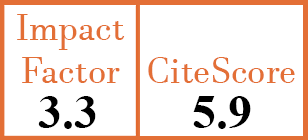Full Papers
DAPSA, DAS28 and MDA predict long-term treatment regime in psoriatic arthritis. The Swedish Early Psoriatic Arthritis Cohort
U. Lindqvist1, M.-L. Wernroth2, T. Husmark3, P. Larsson4, M. Geijer5, A. Teleman6, E. Theander7, G.-M. Alenius8
- Department of Medical Sciences, Rheumatology, Uppsala University, Sweden. ulla.lindqvist@medsci.uu.se
- Uppsala Clinical Research Centre, Uppsala University, Sweden.
- Department of Rheumatology, Falu Hospital, Falu, Sweden.
- Department of Rheumatology, Karolinska University Hospital, Huddinge, Stockholm, Sweden.
- Department of Clinical Sciences, Lund University; and Department of Radiology, University Hospital, Örebro, Sweden.
- Spenshult Hospital, Spenshult AB, Oskarström, Sweden.
- Department of Rheumatology, Skåne University Hospital Malmö, Lund University, Sweden.
- Department of Public Health and Clinical, Medicine/Rheumatology, Umeå University, Sweden.
CER10012
2017 Vol.35, N°6
PI 0936, PF 0942
Full Papers
Free to view
(click on article PDF icon to read the article)
PMID: 28628468 [PubMed]
Received: 12/10/2016
Accepted : 20/03/2017
In Press: 16/06/2017
Published: 11/12/2017
Abstract
OBJECTIVES:
To describe treatment patterns in the Swedish early psoriatic arthritis cohort (SwePsA) of the mono-/oligo-arthritic (M/O) and polyarthritis (P) and identify early predictive factors for treatment with disease-modifying anti-rheumatic (DMARD), non-steroidal anti-inflammatory drugs (NSAID), and tumour necrosis factor inhibition (TNFi) after 5 years.
METHODS:
Data for 198 M/O and P PsA were obtained within the programme for SwePsA. Multinomial and binary logistic regression analyses were used to assess the association between early predictive factors and treatment after 5 years adjusted for age at inclusion. The analysis of DMARD/NSAID was adjusted for medication at inclusion.
RESULTS:
After inclusion visit, DMARD was prescribed in 30% of M/O and 56% of P PsA; mainly methotrexate. TNFi was not prescribed at inclusion, but 23 patients were treated at 5-year follow-up. The adjusted OR (95% CI) for treatment with both DMARD and NSAID after 5 years was 3.65 (1.34 - 9.89) (p=0.010) for Disease Activity Score 28 (DAS28) >3.2 and 2.90 (1.20–6.99) (p=0.038) for Disease Activity Index in Psoriatic Arthritis (DAPSA) >14 at inclusion. TNFi treatment was, after adjusting for age, associated with high erythrocyte sedimentation rate (p=0.0043), high C-reactive protein (p=0.013), DAPSA (p<0.001), not reaching minimal disease activity (p=0.001) high health assessment questionnaire (p=0.001), patient's overall assessment on the visual analogue scale (VAS) (p=0.009), high pain VAS (p=0.007), and high number of tender and swollen joints (p=0.031) at inclusion.
CONCLUSIONS:
Disease activity in early M/O and P PsA is to be considered in deciding the level of health care assessment and future pharmacological treatment. DAS28 >3.2 and DAPSA>14 early in the disease predict subsequent treatment with DMARD. For prediction of biological treatment, not reaching MDA at onset of disease, would be the composite index of choice.


